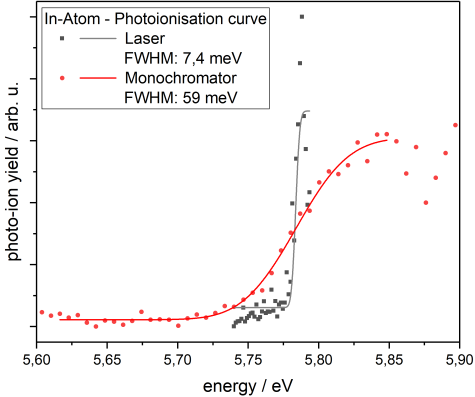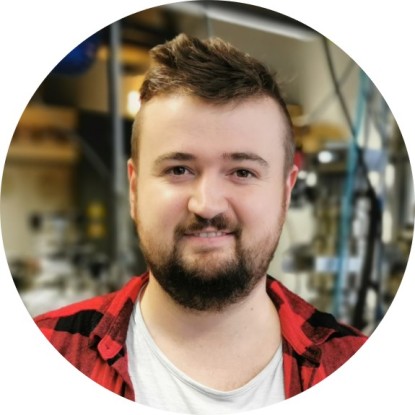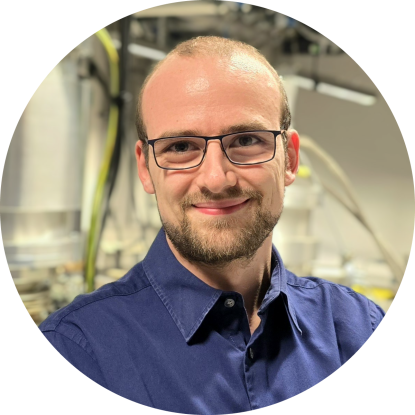The tunable laser system (1.9-5.4eV) with an optical parametric oscillator (OPO) at its core piece has a resolution and step size of about 0.01nm which enables the detection of the vibrational fine structure within an electronic excitation (or vibronic fine structure in the case of electronic-vibratory coupling). The spectral shape of the absorption band depends strongly on the underlying mechanism of fragmentation and can vary, for example, between wide, unstructured bands in the case of an excitation into a dissociative potential curve and a series of narrow, superimposed vibrational progressions as a result of electronic or vibratory predissociation.
Compared to prominent organic vibrations, the vibrations of a cluster are often significantly smaller and thus already excited at comparatively low temperatures. As a result, additional progressions due to electronic transitions from already vibratory-excited energy levels (hot bands) occur in the absorption spectrum and signal assignment and spectral evaluation becomes more difficult. From an experimental point of view, it is therefore advisable to cool the clusters below the temperature equivalent to their vibrational excitation. For this purpose, a cryogenic nozzle within the laser evaporation source is currently being planned, as shown in Fig. 1. In the future, temperatures of a few Kelvin are to be reached with it.
The state-of-the-art VUV laser system makes it possible to record very well resolved photoionization spectra with an accuracy of a few meV compared to previous setups (monochromator and flash lamp). The more accurately the slope can be recorded, the more accurately the ionization potential can be determined, because this corresponds to the position of the inflection point of the ionization curve.
Fig. 2 shows the comparison between the two measurement methods using the indium atom. Although only a smaller energy range can be covered by the laser system, the photoionization curve obtained is more accurate by a factor of ~10 (bandwidth: 7.4 to 59 meV).
Atoms are characterized by the fact that the slope of the ionization curve is very steep, since there is no vibrational excitation. If now the atom is changed to a cluster, this slope is broadened by the added vibrational excitation. As a result, the ionization potential cannot be determined exactly.
To damp the vibrational excitation of the clusters, the cryogenic nozzle presented in the chapter “Vibrationally-resolved absorption spectroscopy” can be used. Thus, it is also possible to obtain vibrationally resolved spectra, since the VUV laser system offers an accuracy of less than 0.01 nm.
The presence of several isomers of one cluster size leads to a superposition of the absorption spectra complicating the validation of postulated geometries from quantum chemistry and also significantly limits the information content that can be inferred from the analysis of the electronic excitations. Although in some cases the transformation of the structural isomers can be prevented by cryogenic cooling below the isomerization energy, it is often still above this threshold.
The isomerization is often accompanied by a structural distortion that alters (often reduces) the symmetry of the system and thus opens the possibility to separate structural isomers via their electrical dipole moment before the dissociation laser is employed. The associated experimental modification and the construction of an electrical deflection unit is closely related to the research field of molecular beam deflection.
AK Schäfer participates in the Collaborative Research Center 1487 of the TU-Darmstadt (Link) with the investigation of clusters doped with iron. This project is mainly performed by VUV spectroscopy and molecular beam deflection. First results could already be obtained by measuring the ionization potentials with the Xe flash lamp. For example, the binding of 10 Sn atoms to an iron atom leads to a lowering of its IP by 0.52eV. These first results must now be further validated and extended. However, the light intensity of the xenon flash lamp is not sufficient for this purpose, which is why another VUV light source must be set up.
For this purpose, the extension of the VUV laser system to a wavelength <190 nm is planned. To achieve such low wavelengths, wavelength mixing in a crystal is no longer possible. Gases such as xenon or krypton must be used as an alternative. By wavelength mixing in a xenon cell, it is thus possible to achieve wavelengths down to 150 nm, which corresponds to energies of up to 8.25 eV. With these energies it is then possible to accurately measure the ionization curves for tin-iron species.







